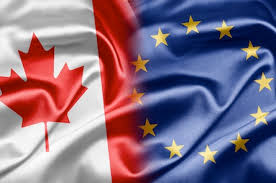EU and Canada signed CETA; a trade deal that sets a new standard for global trade

On 30 October, the EU and Canada sign a trade agreement, known as the Comprehensive Economic and Trade Agreement (CETA).
This deal will create jobs and growth by boosting trade and strengthening economic relations. CETA’s progressive nature will set a new global standard for sustainability chapters in trade agreements. It will make business with Canada easier, remove customs duties, substantially improve access to public contracts, open up new sectors of the Canadian services market, offer predictable conditions for investors, and protect Geographical Indications. Companies in several sectors will also benefit from the gains derived from the elimination of double testing, in particular small and medium enterprises (SMEs).
With CETA, the EU and Canada are committed to ensure that economic growth, social development and environmental protection are mutually supportive.
Cutting tariffs worth over €500 million a year to benefit businesses big and small
CETA will bring tangible benefits to European companies by getting rid of 99% of tariffs, in most cases as soon as the deal comes into effect. As of the first day of its implementation, Canada will eliminate duties worth €400 million for goods originating in the EU. At the end of transitional periods for duty elimination, that figure will rise to more than €500 million a year.
Greater choice for the EU’s 500 million consumers while maintaining current quality standards
Opening markets also has the potential to keep prices down and provide consumers with more choice. At the same time, free trade does not mean lowering or changing EU standards that protect people’s health and safety, social rights, their rights as consumers and the environment. These standards will remain untouched, and imports from Canada will have to satisfy all EU product rules and regulations – without exception. This means that CETA will not change the way the EU regulates food safety, including on GMO products or the ban on hormone-treated beef.
Opening up the Canadian services market and encouraging investment
CETA is by far the most far reaching agreement ever concluded by the EU in the area of services and investment. European firms will have new advantages when it comes to getting investment projects approved in Canada. European firms will also have more opportunities to provide services, for example, specialised maritime services like dredging, moving empty containers, or shipping certain cargo within Canada. In other service sectors, such as environmental services, telecom and finance, market access is ensured, both at federal level and – for the first time – provincial level. In CETA – as in all its trade agreements – the EU fully protects public services.
Mutual recognition of professional qualifications
The agreement provides a framework to approve the recognition of qualifications in regulated professions such as architects, accountants and engineers. The relevant professional organisations in the EU and Canada will have to jointly work out the technical details of recognition of their respective qualifications on the basis of the framework. The competent authorities in Canada and the EU will then approve their work and give it legal effect.
Fewer restrictions on moving across the Atlantic for temporary work
CETA will make it easier for company staff and other professionals to work on the other side of the Atlantic, and for firms to move staff temporarily between the EU and Canada. This will help European companies run their operations in Canada. It will be also easier for other professionals to temporarily supply legal, accounting, architectural or similar services.
Making European firms more competitive on the Canadian market
CETA will make European firms more competitive on the Canadian market by making it easier for them to provide after–sales service. This will help EU firms to export equipment, machinery and software by allowing them to send maintenance engineers and other specialists to provide after-sales and related services and support.
Giving EU firms unprecedented access to government tenders
Canada has opened up its government tenders to EU companies to a greater extent than with any of its other trading partners. EU firms will be able to bid to provide goods and services not only at the federal level but also to Canadian provinces and municipalities – the first non-Canadian firms to be able to do so. Canada’s provincial procurement market is estimated to be double the size of its federal equivalent. Canada has also agreed to step up transparency by publishing all its public tenders in a single procurement website. Access to information is one of the biggest obstacles for smaller companies in accessing international markets, so this will be a boon for smaller businesses in Europe.
Cutting companies’ costs without cutting corners on standards
EU and Canada have agreed to accept each other’s conformity assessment certificates in areas such as electrical goods, electronic and radio equipment, toys, machinery or measuring equipment. This means that, under certain circumstances, a conformity assessment body in the EU can test EU products for export to Canada according to Canadian rules and vice versa. This will avoid both sides doing the same test and could greatly reduce costs for companies and consumers alike. This is of particular benefit to smaller companies for whom paying twice for the same test can be prohibitive.
A reformed system of investment protection
CETA ensures protection for investments while enshrining the right of governments to regulate in the public interest, including when such regulations affect a foreign investment. The traditional form of investor-state dispute settlement that exists in many trade agreements negotiated by Member States (known as ISDS) has been replaced with a new and improved Investment Court System (ICS).
The new mechanism will be a public one – not based on ad hoc tribunals. It will have professional and independent judges appointed by the EU and Canada and held to the highest ethical standards through a strict code of conduct. Its procedures will be transparent, including by opening up hearings and publishing documents submitted during cases. The investment provisions narrow down the cases when an investor can challenge a State, and afford no protection for so-called shell or mailbox companies – only companies with a real economic link are eligible. In no case may a public entity be forced to change a piece of legislation or pay punitive damages.
The reformed ICS is a new feature of trade agreements, and the relevant public debate is not finalised in many Member States. Therefore, the choice of Member States, supported by the Commission, is that ICS will be out of the scope of provisional application of CETA, meaning that it will only be implemented once all Member States conclude their national ratification procedures. During that time, as foreseen in the agreement, the Commission will work with Canada to further elaborate certain parameters of the new system, like the selection of judges, the access by small and medium enterprises to the new system and the appeal mechanism.
New opportunities for farmers and food producers while protecting Europe’s so-called ‘Geographical Indications’
CETA will create new opportunities for farmers and food producers, while fully protecting the sensitivities of the EU. The EU’s openings on certain products are limited and calibrated and are balanced out by Canadian openings that satisfy important European exporting interests, such as cheese, wine and spirits, fruit and vegetables, processed products and geographical indications. All imports from Canada have to satisfy EU rules and regulations. For example, only hormone-free meat will ever be imported into the EU.
CETA is also an important step forward for many medium-sized and smaller businesses in rural communities trading in agricultural products. They will now benefit from Canada agreeing to protect 143 distinctive products from specific geographical regions in the EU. The products which will be protected in CETA are the most exported EU food and drink products ranging from Roquefort cheese, to balsamic vinegar from Modena and Dutch Gouda cheese. European products will be protected from imitations at a level comparable to EU law and will avoid the risk of being considered generic in Canada.
Protecting Europe’s innovators and artists
CETA will create a more level playing field between Canada and the EU in the area of Intellectual Property Rights (IPR). For example, it will strengthen the protection of copyrights by aligning Canadian rules with those of the EU on protection of technological measures and digital rights management. It will also improve how Canada’s IPR system protects patents for EU pharmaceutical products. It will also bolster enforcement by foreseeing the possibility of provisional measures and injunctions for intermediaries involved in infringing activities. Canada also agreed to strengthen its border measures against counterfeit trademark goods, pirated copyright goods and counterfeit geographical indication goods.
Protecting people’s rights at work and the environment
In CETA the EU and Canada affirm their commitment to sustainable development. Both agree that more trade and investment should further environmental protection and labour rights – and not be at their expense. The EU and Canada are committed to CETA helping to ensure that economic growth, social development, and environmental protection are mutually supportive. CETA integrates the EU’s and Canada’s obligations to international rules on workers’ rights and environmental and climate protection. CETA gives a strong role to EU and Canadian civil society in participating in the implementation of the commitments in these areas in CETA. CETA also sets up a process for settling disputes, including government consultations and a panel of experts.
Joint Interpretative Instrument
Together with CETA, the EU and Canada signed a Joint Interpretative Instrument, a document that will have legal force and that will further clarify, in a clear and unambiguous way, what Canada and the European Union have agreed in a number of CETA articles (like on the new Investment Court System, on the right to regulate, on public services or on labour and environmental protection).
Background and next steps
After signature, the European Parliament must give its consent to CETA for it to enter into force provisionally. Provisional application, once an agreement has been approved by Member States in the Council and by the European Parliament, allows European businesses and consumers to reap the benefits of the agreement early on, for those areas that fall under EU exclusive or shared competence.
Source: European Commission





























